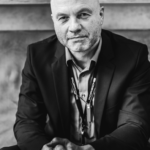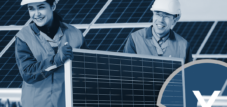Published on: April 10, 2025 / update from: April 10, 2025 - Author: Konrad Wolfenstein

Solarpark Fünseichen near Eisenhüttenstadt: Investor exit and the uncertain future of the PV system Fünseichen-Symbol image: Xpert.digital
Does the energy transition fail? Investor retreat threatens Solarpark in five-ponds
Future of renewable energies: Solar park in five -ponds before the uncertain future
The location of the planned solar park in five -ponds near Eisenhüttenstadt remains uncertain after an important investor has withdrawn its commitment. This raises questions about the future of renewable energies in the region and illustrates the challenges of implementing the energy transition in structurally weak areas. The situation reflects a trend that can be observed in various regions of Germany, where ambitious solar projects encounter obstacles.
Suitable for:
- Solar energy expansion in Brandenburg: Three XL-Solarpark major projects in focus-Neuruppin, Vierlinden (Görlsdorf) to Ketzin
Solar energy as a hope for structural change
The use of renewable energies, in particular photovoltaics, is a promising path to economically revitalize former open -cast venue. A study on behalf of the Federal Ministry of Economic Affairs and Energy (BMWi) from 2018 underlines the considerable potential of renewable energies for structural change in these areas. The planning, construction and operation of photovoltaic and wind turbines can result in employment effects from up to 1,000 full-time equivalents- regardless of further potentials from production.
Brandenburg has considerable solar resources. The solar potential analysis for the country shows that the region offers good conditions for solar power generation. Outdoor facilities, which make up about 68% of the installed performance in Brandenburg, play an important role.
The situation in Eisenhüttenstadt and Fünseichen
Eisenhüttenstadt, once founded as a socialist model city, has been experiencing an economic structural change for years. The city that was formerly characterized by the Eisenhüttenkombinat Ost is looking for new perspectives. Five oaks, a district of Eisenhüttenstadt, are best known for his school and is regularly approached by bus line 443, which runs from the Eisenhüttenstadt ZOB.
The regional conditions for solar energy are fundamentally favorable. With over 1,000 hours of sunshine a year, the region offers good conditions for photovoltaic systems, as local providers of solar installations emphasize. The geographical location and the existing infrastructure could create productive framework conditions for solar projects.
Challenges for solar projects: a broader picture
The current difficulties at the Fünichen solar park are exemplary for several systemic problems that affect photovoltaic projects in Germany:
Network capacities and discount problems
A central problem for many photovoltaic projects is the limited capacity of the power grids. If many PV systems incorporate electricity into the network at the same time, network operators often have to temporarily adjust individual systems in order to protect the network from overload. This practice can mean significant financial losses for plant operators. An example from Bavaria shows how a butcher's shop with a 200-kilowatt system is completely settled on sunny days between 10 a.m. and 5 p.m., which leads to costs of up to 500 euros a day.
Maximilian Zängl from the network operator Bayernwerk justifies these measures with the need to ensure network stability. Despite investing of five billion euros in the network expansion by 2026, the company expects three million interventions to the network for 2024.
Regulatory changes
Legal changes create additional uncertainty. Since February 2025, the remuneration rates for fed -up solar power have dropped to 7.95 cents per kilowatt hour (kWh) for self -supply systems up to 10 kilowatts. In addition, operators of new photovoltaic systems no longer receive a feed -in tariff if there is a power oversurance on the market and there are negative electricity prices on the electricity exchange.
Acceptance problems and space competition
The use of agricultural areas for solar parks is increasingly encountering resistance. An example from Villingen-Schwenningen shows how attempts to realize a solar park with up to 25 hectares failed due to the rejection of farmers. The owners and tenants were able to convince neither lucrative lease contracts nor attempts to achieve the goal through land exchange.
Financing models and citizen participation as an alternative
Despite the challenges, successful projects in other regions show that alternative financing models can work. In Epfendorf, a 3.4 MWP agricultural solar park was realized by crowd investing. Investors were able to participate from 500 euros and received a fixed interest rate of 4.5% PA, even 6% for residents of Epfendorf.
Similar approaches are shown in Rottenacker, where a solar park with a nominal output of 6.4 megawatts does not require remuneration from the EEG and instead concludes direct power delivery contracts with regional companies. Citizen participation is also offered there, which are aimed specifically at the residents of the surrounding communities.
Economic importance for structurally weak regions
The economic importance of solar projects for structurally weak regions must not be underestimated. South of Leipzig, for example, a gigantic solar park was created on a former lignite mining area. The project is financed by Signal Iduna through her daughter Hansainvest Real Assets with a medium three -digit million amount. The long -term investment has been created for at least 30 years and promises a stable yield in the single -digit percentage range per year.
Such major projects can have a signaling effect and show that renewable energies can represent an economically viable alternative for former industrial locations.
Innovative approaches: solar systems in landfills
Disappeared landfills offer an alternative option. The Bavarian State Office for the Environment expressly advocates the construction of photovoltaic systems in landfills, since it is an environmental and resource-friendly type of decentralized electricity generation. The advantages include the lack of additional land consumption (area recycling), the fact that other uses are not affected, and the existing infrastructure.
The municipal perspective: municipalities as actors
Municipalities can play an active role in promoting solar energy. One example is the city of Friedland in Lower Lusatia, which, according to current reports, plans to produce its own electricity. Such municipal initiatives can provide important impulses for the regional energy transition.
Suitable for:
Effects for the Eisenhüttenstadt region
For Eisenhüttenstadt, the possible loss of the solar park project in five-ponds not only means the elimination of potential tax revenue, but also missed opportunities for jobs and regional added value. In a city that has been struggling with economic challenges since the fall of the wall - symbolically embodied by the long neglected hotel “Lunik”, which could only be bought back from the city recently - new economic impulses would be particularly valuable.
Perspectives and options for action
Despite the current difficulties at the Fünfichen solar park, there are ways to revive the project or to find alternative ways:
Strengthen citizen participation
Following the model of successful projects, a stronger integration of the local population through citizens' energy cooperatives or crowdfunding models could revive the project. The experiences from Epfendorf and other locations show that higher chances of return for local investors can increase acceptance.
Local engagement
Similar to Friedland, the city of Eisenhüttenstadt could play a more active role and act as an investor or project developer. This would not only strengthen local control over the project, but also ensure that the economic advantages remain in the region.
Check alternative locations
If the originally planned location is not feasible in five -ponds, alternative areas such as former industrial throats or conversion areas could be considered. In particular, the use of landfills or other pre -loaded areas could reduce acceptance problems.
Solarpark Fünseichen: Learning process for the energy transition in crisis regions
The situation of the five -pitch solar park near Eisenhüttenstadt illustrates the complex challenges of the energy transition in structurally weak regions. Despite favorable natural conditions and potential economic advantages, regulatory uncertainties, short passports and acceptance problems can be doomed.
Nevertheless, successful examples from other regions show that innovative financing models, strong local participation and creative solutions for the land use of solar parks can also be realized under difficult conditions. For Eisenhüttenstadt and the region, it is to be hoped that, despite the current setback, new ways will be found to use the potential of solar energy for regional structural change.
The energy transition offers a chance for former industrial locations to re -position and create a sustainable economic basis. Experience with the five -pounds solar park should therefore be understood as a learning process in order to make future projects more successful.
Suitable for:
Your partner for business development in the field of photovoltaics and construction
From industrial roof PV to solar parks to larger solar parking spaces
☑️ Our business language is English or German
☑️ NEW: Correspondence in your national language!
I would be happy to serve you and my team as a personal advisor.
You can contact me by filling out the contact form or simply call me on +49 89 89 674 804 (Munich) . My email address is: wolfenstein ∂ xpert.digital
I'm looking forward to our joint project.













